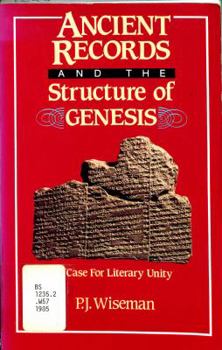Ancient Records and the Structure of Genesis: A Case for Literary Unity
Biblical Book of Genesis Non-Fiction This description may be from another edition of this product.
Format:Hardcover
Language:English
ISBN:0840775024
ISBN13:9780840775023
Release Date:January 1985
Publisher:Thomas Nelson Publishers
Length:148 Pages
Weight:0.70 lbs.
Customer Reviews
3 ratings
Interesting theory
Published by Thriftbooks.com User , 23 years ago
The "Gilgamesh Epic" records a story of a world-wide flood and pre-dates Genesis. So some claim that this invalidates the Genesis record. But P.J. Wiseman presents an interesting theory in this regard in this book.He believes that Moses did not WRITE Genesis but rather TRANSLATED it from ancient stone tablets written in Cuneiform script. The tablets each would have been originally written by eye-witnesses of the particular events, or those who received their information from eye-witnesses.He breaks Genesis into parts according to the phrase "These are the generations" (KJV; "This is the history" - NKJV; "This the account" - NASB; NIV; Gen 2:4; 5:1; 6:9; 10:1; 11:10; 11:27; 25:12,9; 36:1,9; 37:2).He compares the use of this phrase and the structure of each section to the stone tablets written in cuneiform script. Many of these tablets have been discovered and they date to the third millenium BC.Wiseman's theory is that Genesis is translated from individual tablets which would have contained the material before each occurrence of the above phrase. So the narratives of the creation of the universe (Gen 1) and of the Garden of Eden (Gen 2) would have been written on one tablet by Adam as these events were revealed to him by the only Eye-witness of the events, God Himself.The narratives of the Fall and subsequent events would have been written on another tablet by Adam as an eye-witness of the events. Adam then passed each of these tablets on to his descendant Seth. Seth then recorded the events of Gen 5 and passed the tablets to his descendant Noah. Noah then recorded the events of Gen 6-9 and passed the tablets to his descendant Shem, and so one until Joseph. Joseph then recorded the final chapters of Genesis and placed all of the tablets in the library of the pharaohs. Moses then, while in pharaoh's court, would have had access to these tablets. He then translated them into his native Hebrew.The above theory "fits" with various evidences in the Scriptures. For instance, it would explain such passages as Exod 6:3: "I appeared to Abraham, to Isaac, and to Jacob, as God Almighty, but by My name, LORD [YHWH], I was not known to them." But the Tetragrammaton appears in Genesis, making for an apparent contradiction. However, this problem is easily explained if Moses translated, but did not write, Genesis. While translating, when Moses came across the name for God in the cuneiform tablets, he used the Name God revealed to him to translate it. So the Name YHWH was not known to Abraham and other Genesis figures.Also, note that in the Bible Genesis is never said to be written by Moses, whereas the other four books of the Torah are. For instance, in Matt 18:4-5 Jesus refers to two quotes from Genesis. He introduces them with the general phrase, "Have you not read...." But in verse 8, when referring to a passage from Deuteronomy, Jesus specifically attributes the statement to Moses.In addition, Wiseman's theory is consistent with the relationship of Gilgamesh
I love this book.
Published by Thriftbooks.com User , 25 years ago
The most important and overlooked work on the first page of the Bible. Wiseman offers a simple, and I believe accurate explanation of the structure of Genesis 1. It is amazing that both the scientific and theological communities have missed this. It resolves once and for all the conflict between the Creationists and Evolutionists. Wiseman says, "If you're looking to this 'creation account' to learn the origin of life on earth, you're looking in the wrong place. The account doesn't address the mechanics of how things came to be." Wiseman has also published these ideas under the title "Creation Revealed in Six Days" - also out of print.
Proof of the age, transmission and authenticity of Genesis
Published by Thriftbooks.com User , 27 years ago
Although not given the attention it is due by the more traditional scholarly press, this small book proves conclusively that Genesis was written originally on clay tablets in cuneiform by the patriarchs themselves. The author, who visited archaelogical sites early in this century and studied the methods of creation and transmission of texts from one tablet to another has been able to show conclusively that the book of Genesis has the section ending "markers" that were used in the very earliest writings of man dating from 3000 B.C. His theory is both intriguing and convincing, and deserves greater attention than it received when it was published. If he is vindicated the traditional JEPD methodology for describing the collation and transmission of the Genesis stories will be thrown on its ear completely. For this reason the more liberal school of biblical criticism has ignored the findings of Wiseman. Conservative Christians will find in this book the sort of evidence that "demands a verdict." I highly recommend it for all students of the Bible who have an open mind for the truth, and especially for those who are interested in seeing, once again, that the Bible is exactly what it has always claimed to be.






